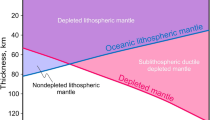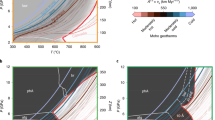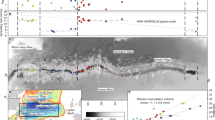Abstract
Shatsky Rise is a large oceanic plateau formed at a spreading ridge triple junction, but its origin mechanism is unclear. Voluminous magmatism at Shatsky Rise has been regarded either as the product of decompression melting of fertile recycled material in a divergent plate boundary setting (plate model) or a hot mantle plume head (plume model). Here we use thermodynamic models to simulate decompression melting of heterogeneous mantle sources. We provide constraints on both mantle potential temperature and fertile source abundance under seafloor spreading and plume–ridge interaction scenarios. As constrained by crustal thickness and lava chemical compositions, a seafloor spreading origin requires mantle potential temperatures of 1,490–1,585 °C, which are unreasonably high for mid-ocean ridge systems far from hotspots. In contrast, the plume–ridge interaction model can explain observations with mantle potential temperatures of 1,470–1,515 °C for the buoyant plume and upwelling rates up to six times the rate of plate separation during the formation of the main massifs. Fertile recycled material comprises less than 7% of the mantle source, and predicted melt fractions are consistent with independent estimates. We thus suggest that Shatsky Rise magmatism is best explained by plume–ridge interaction—a combination of the plume and plate models.
This is a preview of subscription content, access via your institution
Access options
Access Nature and 54 other Nature Portfolio journals
Get Nature+, our best-value online-access subscription
$29.99 / 30 days
cancel any time
Subscribe to this journal
Receive 12 print issues and online access
$259.00 per year
only $21.58 per issue
Buy this article
- Purchase on Springer Link
- Instant access to full article PDF
Prices may be subject to local taxes which are calculated during checkout






Similar content being viewed by others
Data availability
Code availability
The REEBOX PRO was downloaded from https://geo.au.dk/en/research/research-areas/department-groups/earth-system-petrology/reebox-pro. For more details of the model, please contact E.L.B. (ericlb@geo.au.dk).
References
Coffin, M. F. & Eldholm, O. Large igneous provinces: crustal structure, dimensions, and external consequences. Rev. Geophys. 32, 1–36 (1994).
Kerr, A. C. in Encyclopedia of Marine Geosciences (eds Harff, J. et al.) 558–567 (Springer, 2016).
Morgan, W. J. Convection plumes in the lower mantle. Nature 230, 42–43 (1971).
Richards, M. A., Duncan, R. A. & Courtillot, V. E. Flood basalts and hot-spot tracks: plume heads and tails. Science 246, 103–107 (1989).
Richards, M. A., Jones, D. L., Duncan, R. A. & DePaolo, D. J. A mantle plume initiation model for the Wrangellia flood basalt and other oceanic plateaus. Science 254, 263–267 (1991).
Duncan, R. A. & Richards, M. Hotspots, mantle plumes, flood basalts, and true polar wander. Rev. Geophys. 29, 31–50 (1991).
Foulger, G. R., Natland, J. H., & Anderson, D. L. in Plates, Plumes, and Paradigms, Special Paper 388 (eds Foulger, G. R. et al.) 595–626 (GSA, 2005).
Foulger, G. R. in Plates, Plumes and Planetary Processes, Special Paper 430 (eds Foulger, G. R. et al.) 1–28 (GSA, 2007).
Sager, W. W., Handschumacher, D. W., Hilde, T. W. & Bracey, D. R. Tectonic evolution of the northern Pacific plate and Pacific–Farallon Izanagi triple junction in the Late Jurassic and Early Cretaceous (M21–M10). Tectonophysics 155, 345–364 (1988).
Nakanishi, M., Sager, W. W. & Klaus, A. Magnetic lineations within Shatsky Rise, northwest Pacific Ocean: implications for hot spot–triple junction interaction and oceanic plateau formation. J. Geophys. Res. 104, 7539–7556 (1999).
Zhang, J., Sager, W. W. & Korenaga, J. The seismic Moho structure of Shatsky Rise oceanic plateau, northwest Pacific Ocean. Earth Planet. Sci. Lett. 441, 143–154 (2016).
Christeson, G., Goff, J. & Reece, R. Synthesis of oceanic crustal structure from two-dimensional seismic profiles. Rev. Geophys. 57, 504–529 (2019).
Sano, T. et al. Variety and origin of magmas on Shatsky Rise, northwest Pacific Ocean. Geochem. Geophys. Geosyst. 13, Q08010 (2012).
Heydolph, K. et al. Plume versus plate origin for the Shatsky Rise oceanic plateau (NW Pacific): insights from Nd, Pb and Hf isotopes. Lithos 200, 49–63 (2014).
Tejada, M. L. G. et al. Geochemistry and age of Shatsky, Hess, and Ojin Rise seamounts: implications for a connection between the Shatsky and Hess Rises. Geochim. Cosmochim. Acta 185, 302–327 (2016).
Hanyu, T., Shimizu, K. & Sano, T. in The Origin, Evolution, and Environmental Impact of Oceanic Large Igneous Provinces, Special Paper 511 (eds Neal, C. et al.) 57–67 (GSA, 2015).
Sager, W. W. et al. Oceanic plateau formation by seafloor spreading implied by Tamu Massif magnetic anomalies. Nat. Geosci. 12, 661–666 (2019).
Kimura, J. I. & Kawabata, H. Ocean Basalt Simulator version 1 (OBS 1): trace element mass balance in adiabatic melting of a pyroxenite-bearing peridotite. Geochem. Geophys. Geosyst. 16, 267–300 (2015).
Putirka, K. Excess temperatures at ocean islands: implications for mantle layering and convection. Geology 36, 283–286 (2008).
Brown, E. L. & Lesher, C. E. North Atlantic magmatism controlled by temperature, mantle composition and buoyancy. Nat. Geosci. 7, 820–824 (2014).
Huang, Y. et al. Magnetic anomaly map of Shatsky Rise and its implications for oceanic plateau formation. J. Geophys. Res. 126, e2019JB019116 (2021).
Brown, E. L. & Lesher, C. E. REEBOX PRO: a forward model simulating melting of thermally and lithologically variable upwelling mantle. Geochem. Geophys. Geosyst. 17, 3929–3968 (2016).
Brown, E. L., Petersen, K. D. & Lesher, C. E. Markov chain Monte Carlo inversion of mantle temperature and source composition, with application to Reykjanes Peninsula, Iceland. Earth Planet. Sci. Lett. 532, 116007 (2020).
Yasuda, A. & Fujii, T. Ascending subducted oceanic crust entrained within mantle plumes. Geophys. Res. Lett. 25, 1561–1564 (1998).
Bao, X., Lithgow-Bertelloni, C. R., Jackson, M. G. & Romanowicz, B. On the relative temperatures of Earth’s volcanic hotspots and mid-ocean ridges. Science 375, 57–61 (2022).
Niu, Y. & Batiza, R. An empirical method for calculating melt compositions produced beneath mid‐ocean ridges: application for axis and off-axis (seamounts) melting. J. Geophys. Res. 96, 21753–21777 (1991).
Husen, A. et al. Geothermobarometry of basaltic glasses from the Tamu Massif, Shatsky Rise oceanic plateau. Geochem. Geophys. Geosyst. 14, 3908–3928 (2013).
Georgen, J. E. & Lin, J. Three-dimensional passive flow and temperature structure beneath oceanic ridge–ridge–ridge triple junctions. Earth Planet. Sci. Lett. 204, 115–132 (2002).
Georgen, J. E. Mantle flow and melting beneath oceanic ridge–ridge–ridge triple junctions. Earth Planet. Sci. Lett. 270, 231–240 (2008).
Georgen, J. E. & Sankar, R. D. Effects of ridge geometry on mantle dynamics in an oceanic triple junction region: implications for the Azores Plateau. Earth Planet. Sci. Lett. 298, 23–34 (2010).
Campbell, I., Griffiths, R. & Hill, R. Melting in an Archaean mantle plume: heads it’s basalts, tails it’s komatiites. Nature 339, 697–699 (1989).
Campbell, I. H. & Griffiths, R. W. Implications of mantle plume structure for the evolution of flood basalts. Earth Planet. Sci. Lett. 99, 79–93 (1990).
Griffiths, R. W. & Campbell, I. H. Stirring and structure in mantle starting plumes. Earth Planet. Sci. Lett. 99, 66–78 (1990).
Hauri, E. H., Whitehead, J. A. & Hart, S. R. Fluid dynamic and geochemical aspects of entrainment in mantle plumes. J. Geophys. Res. 99, 24275–24300 (1994).
Lin, S. C. & van Keken, P. E. Deformation, stirring and material transport in thermochemical plumes. Geophys. Res. Lett. 33, L20306 (2006).
Keller, R. A., Fisk, M. R. & White, W. M. Isotopic evidence for Late Cretaceous plume–ridge interaction at the Hawaiian hotspot. Nature 405, 673–676 (2000).
Kumagai, I. On the anatomy of mantle plumes: effect of the viscosity ratio on entrainment and stirring. Earth Planet. Sci. Lett. 198, 211–224 (2002).
Dürkefälden, A. et al. Papanin Ridge and Ojin Rise Seamounts (northwest Pacific): dual hotspot tracks formed by the Shatsky plume. Geochem. Geophys. Geosyst. 22, e2021GC009847 (2021).
Ito, G., Lin, J. & Graham, D. Observational and theoretical studies of the dynamics of mantle plume–mid-ocean ridge interaction. Rev. Geophys. 41, 1017 (2003).
Taylor, B. The single largest oceanic plateau: Ontong Java–Manihiki–Hikurangi. Earth Planet. Sci. Lett. 241, 372–380 (2006).
Gente, P., Dyment, J., Maia, M. & Goslin, J. Interaction between the Mid-Atlantic Ridge and the Azores hot spot during the last 85 Myr: emplacement and rifting of the hot spot-derived plateaus. Geochem. Geophys. Geosyst. 4, 8514 (2003).
Sager, W. W., Thoram, S., Engfer, D. W., Koppers, A. A. & Class, C. Late Cretaceous ridge reorganization, microplate formation, and the evolution of the Rio Grande Rise–Walvis Ridge hot spot twins, South Atlantic Ocean. Geochem. Geophys. Geosyst. 22, e2020GC009390 (2021).
Bredow, E. & Steinberger, B. Variable melt production rate of the Kerguelen hotspot due to long-term plume–ridge interaction. Geophys. Res. Lett. 45, 126–136 (2018).
Whittaker, J. et al. Long-term interaction between mid-ocean ridges and mantle plumes. Nat. Geosci. 8, 479–483 (2015).
Mittelstaedt, E., Ito, G. & Behn, M. D. Mid-ocean ridge jumps associated with hotspot magmatism. Earth Planet. Sci. Lett. 266, 256–270 (2008).
Sager, W. W., Sano, T. & Geldmacher, J. Formation and evolution of Shatsky Rise oceanic plateau: insights from IODP Expedition 324 and recent geophysical cruises. Earth Sci. Rev. 159, 306–336 (2016).
Ogg, J. G. in The Geologic Time Scale 2012 (eds Gradstein, F. M. et al.) 85–113 (Elsevier, 2012).
Workman, R. K. & Hart, S. R. Major and trace element composition of the depleted MORB mantle (DMM). Earth Planet. Sci. Lett. 231, 53–72 (2005).
Kogiso, T., Tatsumi, Y. & Nakano, S. Trace element transport during dehydration processes in the subducted oceanic crust: 1. Experiments and implications for the origin of ocean island basalts. Earth Planet. Sci. Lett. 148, 193–205 (1997).
Gale, A., Dalton, C. A., Langmuir, C. H., Su, Y. & Schilling, J. G. The mean composition of ocean ridge basalts. Geochem. Geophys. Geosyst. 14, 489–518 (2013).
Sandwell, D. T. & Smith, W. H. F. Marine gravity anomaly from Geosat and ERS-1 satellite altimetry. J. Geophys. Res. 102, 10039–10054 (1997).
Pertermann, M. & Hirschmann, M. M. Anhydrous partial melting experiments on MORB-like eclogite: phase relations, phase compositions and mineral-melt partitioning of major elements at 2–3 GPa. J. Petrol. 44, 2173–2201 (2003).
Pertermann, M. & Hirschmann, M. M. Partial melting experiments on a MORB-like pyroxenite between 2 and 3 GPa: constraints on the presence of pyroxenite in basalt source regions from solidus location and melting rate. J. Geophys. Res. 108, 2125 (2003).
Kogiso, T., Hirose, K. & Takahashi, E. Melting experiments on homogeneous mixtures of peridotite and basalt: application to the genesis of ocean island basalts. Earth Planet. Sci. Lett. 162, 45–61 (1998).
Hirschmann, M. M., Kogiso, T., Baker, M. B. & Stolper, E. M. Alkalic magmas generated by partial melting of garnet pyroxenite. Geology 31, 481–484 (2003).
Herzberg, C. Identification of source lithology in the Hawaiian and Canary Islands: implications for origins. J. Petrol. 52, 113–146 (2011).
Putirka, K. et al. The mantle source of thermal plumes: trace and minor elements in olivine and major oxides of primitive liquids (and why the olivine compositions don’t matter). Am. Mineral. 103, 1253–1270 (2018).
Mahoney, J., Duncan, R., Tejada, M., Sager, W. & Bralower, T. Jurassic–Cretaceous boundary age and mid-ocean-ridge-type mantle source for Shatsky Rise. Geology 33, 185–188 (2005).
Sano, T. et al. Two-stages of plume tail volcanism formed Ojin Rise seamounts adjoining Shatsky Rise. Lithos 372–373, 105652 (2020).
Sun, S.-S. & McDonough, W. F. in Magmatism in the Ocean Basins, Special Publication 42 (eds Saunders, A. D. & Norry, M. J.) 313–345 (Geological Society of London, 1989).
O’Hara, M. J. The bearing of phase equilibria studies in synthetic and natural systems on the origin and evolution of basic and ultrabasic rocks. Earth Sci. Rev. 4, 69–133 (1968).
Walter, M. J. Melting of garnet peridotite and the origin of komatiite and depleted lithosphere. J. Petrol. 39, 29–60 (1998).
Acknowledgements
We are grateful for helpful discussion with Marine Geodynamics Group at South China Sea Institute of Oceanology, Chinese Academy of Sciences. This study is supported by Natural Science Foundation for Distinguished Young Scholars of Guangdong Province (2021B1515020098), National Natural Science Foundation of China (41890813, 42206070, 42376071), Hainan Provincial Natural Science Foundation of China (421QN381), Science and Technology Program of Guangzhou (202201010221), Chinese Academy of Sciences Project (131551KYSB20200021, 133244KYSB20180029, Y4SL021) and Shenzhen Science and Technology Innovation Commission (JCYJ20220818100417038, KCXFZ20211020174803005). E.L.B. is supported by Danmarks Frie Forskningsfond (FNU; 8021-00202B), and W.W.S. is supported by the US National Science Foundation (OCE1832197).
Author information
Authors and Affiliations
Contributions
J.Z. initiated the project. J.Z. and X.Z. conceived the research. E.L.B. and X.Z. designed and conducted numerical modelling. X.B. provided the mantle potential temperatures of global mid-ocean ridges and hotspots. J.L. and W.W.S. advised on result interpretation. X.Z., E.L.B. and J.Z. drafted the paper, and all authors discussed the results and commented on the paper.
Corresponding authors
Ethics declarations
Competing interests
The authors declare no competing interests.
Peer review
Peer review information
Nature Geoscience thanks Keith Putirka, Takashi Sano and the other, anonymous, reviewer(s) for their contribution to the peer review of this work. Primary Handling Editor: Xujia Jiang, in collaboration with the Nature Geoscience team.
Additional information
Publisher’s note Springer Nature remains neutral with regard to jurisdictional claims in published maps and institutional affiliations.
Extended data
Extended Data Fig. 1 Geochemical characteristics of Shatsky Rise magmatism.
(a, b) Trace element ratios Zr/Ti and Nb/Sc versus Nb/Ti. (c) Primitive mantle normalized trace element patterns. (d) Source-age corrected 143Nd/144Nd and 176Hf/177Hf isotopic compositions. Based on the trace element ratios, the samples were divided into four types: U1349, Normal, Low-Ti, and High-Nb types13. The trace element data were selected from refs. 13,58. The 143Nd/144Nd and 176Hf/177Hf isotopic data were selected from refs. 14,15,59. The NMORB and OIB (Ocean Island Basalt) reference data were selected from ref. 60. For comparison, the geochemical data of samples drilled from nearby normal oceanic crust14 (ODP Site 1179) and Hess Rise15 (DSDP Sites 464 and 465) were also included.
Extended Data Fig. 2 Geophysical and geochemical properties of different peridotites and pyroxenites.
(a) Solidi of DMM, enriched peridotite (pyrolite), and pyroxenites (G2, KG1, and MIX1G). The solidi were selected from refs. 22,23. The adiabat was calculated by the REEBOX PRO model with Tp of 1360 °C. (b) Natural pyroxenite compositions (grey circles) plotted in the projection scheme of ref. 61. The G2, KG1 and MIX1G pyroxenites included in REEBOX PRO span much of this range, with KG1 and MIX1G pyroxenites plotting on the silica-deficient side (SD) and G2 pyroxenite plotting on the silica-excess (SE) side of the En-CaTs tie-line. Pyrolite62 and DMM48 compositions are shown in green for reference. Fo = Forsterite, CaTs = Calcium Tschermak, En = Enstatite, and Di = Diopside.
Extended Data Fig. 3 Solidus mineral modes parameterized in REEBOX PRO.
(a) DMM, (b) pyrolite, (c) G2 pyroxenite, (d) KG1 pyroxenite, and (e) MIX1G pyroxenite.
Extended Data Fig. 4 Decompression melting behavior of homogeneous and heterogeneous mantle sources.
The Tp was set as 1360 °C. (a) Decompression melting behavior of a homogeneous mantle source assuming 100% of each individual lithology. (b–e) Decompression melting behavior of a heterogeneous mantle source with 95% DMM and 5% pyrolite or 5% pyroxenite (G2, KG1, and MIX1G).
Supplementary information
Supplementary Information
Model sensitivity analysis, Supplementary Figs. 1–26, Table 1 and References.
Rights and permissions
Springer Nature or its licensor (e.g. a society or other partner) holds exclusive rights to this article under a publishing agreement with the author(s) or other rightsholder(s); author self-archiving of the accepted manuscript version of this article is solely governed by the terms of such publishing agreement and applicable law.
About this article
Cite this article
Zhang, X., Brown, E.L., Zhang, J. et al. Magmatism of Shatsky Rise controlled by plume–ridge interaction. Nat. Geosci. 16, 1061–1069 (2023). https://doi.org/10.1038/s41561-023-01286-0
Received:
Accepted:
Published:
Issue Date:
DOI: https://doi.org/10.1038/s41561-023-01286-0



